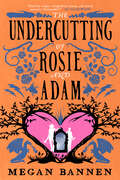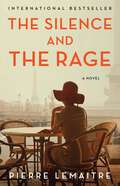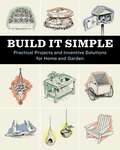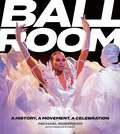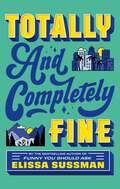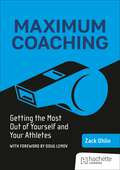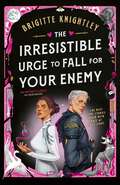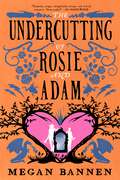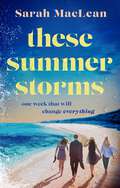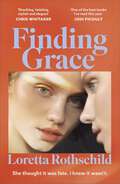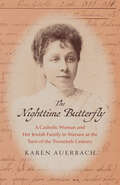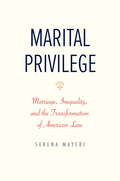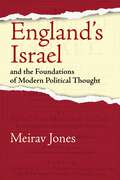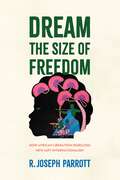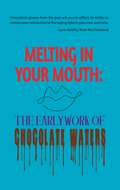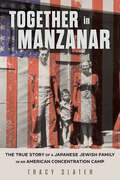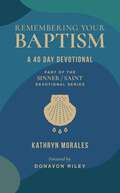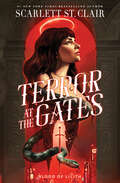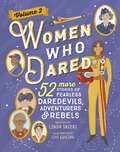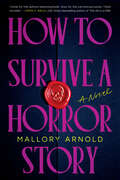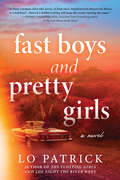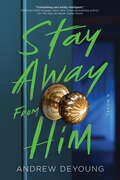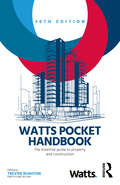- Table View
- List View
The Undercutting of Rosie and Adam
by Megan BannenFrom the author of The Undertaking of Hart and Mercy comes a new heartwarming fantasy rom-com with an opposites-attract twist set in the delightful, donut- and dragon-filled world of Tanria. Immortal demigod Rosie Fox has been patrolling Tanria for decades, but lately, the job has been losing its luster. When Rosie dies (again) by electrocution (again) after poking around inside a portal choked with shadowy thorns, she feels stuck in the rut that is her unending life. The portal&’s uptight creator, Adam Lee, must come in person to repair the damage. But when all the portals break down at once, Rosie and Adam wind up trapped inside the Mist. And the reticent inventor in his bespoke menswear seems to know a lot more about what&’s happening than he lets on. Maybe two people who have found themselves stuck in this thorny, tangled life together can find a way to unstick each other … just when their time on this earth seems to be running out.
The Silence and the Rage
by Pierre LemaitreFrom &“a novelist at the height of his powers,&” a dramatic and jubilant dive into France in the &“glorious years&” of the 1950s, through the lens of one ambitious, troubled, and utterly compelling family (La Croix). It is 1952 and the grown children of Louis Pelletier, a prominent businessman with a dark past, have settled in Paris. Jean, the menacing eldest brother, is trapped in a stifling marriage, his days lightened only by his love for his three-year-old daughter. Meanwhile, the bloody consequences of his violent impulses threaten to catch up to him at last. François, an up-and-coming reporter, is caught up in a turbulent love affair with an intriguing woman who isn&’t quite the person she pretends to be. And Hélène, their younger sister, strives to make her own way as a journalist as she fights to expose a vast industrial scandal. But as a woman in a man&’s world, Hélène&’s devotion to her career comes at a life-threatening cost. Dark and compelling, witty and vivid, and filled with surprising reversals and cliffhangers, The Silence and the Rage is the story of one remarkable family against the backdrop of France during one of its most thrilling and volatile periods.
Moon Joshua Tree & Palm Springs: Hiking, Scenic Drives, Desert Getaways (Moon National Parks Travel Guide)
by Jenna Blough Moon Travel GuidesFrom the chic pools of Palm Springs to the rugged beauty of Joshua Tree National Park, soak up the California sunshine with Moon Joshua Tree & Palm Springs. Inside you'll find: Flexible itineraries, like a three-day camping trip in Joshua Tree National Park and a relaxing five-day stay in Palm Springs and the Coachella Valley, including day trips to Whitewater Preserve and Idyllwild Strategic advice for outdoor adventurers, spa-seekers, poolside loungers, and more The best hikes in Joshua Tree and the Palm Springs area marked with mileage, duration, difficulty level, and elevation gain, plus trailheads and detailed directions Top activities and unique experiences: Discover hidden waterfalls, fan palm oases, and stunning canyons on a hike through Joshua Tree, or trek part of the Pacific Crest Trail on a day trip to the Sand to Snow National Monument. Try a rejuvenating sound bath or soak in serene hot springs. Admire midcentury architecture and sip retro-chic cocktails in Rat-Pack-era hangouts and sample the best of the party scene, from poolside resorts to wild west saloons Insider advice from SoCal local Jenna Blough on when to go, where to stay, and how to get around, including how to get to Joshua Tree and Palm Springs from Los Angeles Full-color photos and detailed maps throughout Background information on the landscape, history, and culture Experience the best of the desert with Moon Joshua Tree & Palm Springs. Exploring California&’s national parks? Check out Moon Death Valley National Park or Moon Yosemite, Sequoia & Kings Canyon.About Moon Travel Guides: Moon was founded in 1973 to empower independent, active, and conscious travel. We prioritize local businesses, outdoor recreation, and traveling strategically and sustainably. Moon Travel Guides are written by local, expert authors with great stories to tell—and they can't wait to share their favorite places with you. For more inspiration, follow @moonguides on social media.
Build It Simple: Practical Projects and Inventive Solutions for Home and Garden
by How-To Experts at Storey PublishingDiscover 50 simple, thrifty, low-tech projects that you can create, even if you're a novice builder! With simple tools and materials and just basic building skills, you can make exactly what you need for all of your backyard and gardening projects, from a tool shed and storage bins to lawn chairs, fences, plant supports, and feeders for your chickens. These sustainable, timeless designs, paired with step-by-step instructions and resourceful tips provide a wealth of ideas for a practical and purposeful garden and home. This publication conforms to the EPUB Accessibility specification at WCAG 2.0 Level AA.
Ballroom: A History, A Movement, A Celebration
by Michael RobersonA gorgeous, authoritative, and image-filled celebration of pageantry and community created by ballroom culture for Black and Brown LGBTQIA+ people. The subculture of Ballroom emerged in Harlem in the &‘60s out of a need for safe and inclusive spaces for Black and Brown queer people, in which family-like "Houses" competed at performative balls, allowing members of this marginalized groups to shine. Thanks to shows like Pose and Legendary, it has grown into a global phenomenon. It offers refuge from the threats and violence against the LGBTQIA+ community while also serving as a testament to the radical nature of queer joy with its pageantry and commitment to chosen family.Ballroom: A History, A Movement, A Celebration is an exhaustively researched tome honoring where Ballroom began and where it is now. It explores how Ballroom has served the Black and Brown LGBTQIA+ community. Bringing both an authoritative and entertaining sweep to this hugely important and influential cultural sensation, this book is filled with photos, interviews, and stories, presenting a captivating, well-documented narrative about not only how to survive but how to do so fashionably, glamorously, and in the company of one another.
Totally and Completely Fine: return to the world of FUNNY YOU SHOULD ASK with this emotional second-chance romance
by Elissa SussmanFrom the bestselling author of Funny You Should Ask comes an inspiring romance novel about honouring the past, living in the present, and loving for the future.In her small Montana hometown, Lauren Parker has assumed a few different roles: teenage hellraiser; sister of superstar Gabe Parker; and most recently, tragically widowed single mother. She's never cared much about labels or what people thought about her, but dealing with her grief has slowly revealed that she's become adrift in her own life.Then she meets the devilishly handsome actor Ben Walsh on the set of her brother's new movie. They have instant chemistry, and Lauren realizes that it has been far too long since someone has really and truly seen her. Her rebellious spirit spurs her to dive headfirst into her desire, but when a sexy encounter becomes something more, Lauren finds herself balancing old roles and new possibilities.There's still plenty to contend with: her disapproving mother-in-law, the complications of Ben's fame, and her daughter's unpredictable moods. An unexpected fling seemed simple at the time - so when did everything with Ben get so complicated? And is there enough room in her life for the woman Lauren wants to be?Why readers LOVE Totally and Completely Fine . . . 'This is not just a love story - it's a deeply moving, beautiful exploration of grief, love, and the complicated act of starting over' ⭐⭐⭐⭐⭐'I love this author so much . . . She always makes her characters relatable and down to earth despite their larger-than-life personas' ⭐⭐⭐⭐⭐'I LOVED THIS BOOK . . . [Sussman's] portrayal of grief was both beautiful and heartbreakingly relatable . . . And those little glimpses of Gabe, Chani, and Ollie? Absolute gold' ⭐⭐⭐⭐⭐'Elissa is a master at blending humour and wit with deep feelings and swoony moments' ⭐⭐⭐⭐⭐'Funny and sad and sexy at the same time . . . Sussman's best book yet!' ⭐⭐⭐⭐⭐'A hilarious and beautiful look at finding love again' ⭐⭐⭐⭐⭐'Delightful! A really satisfying continuation of the story Elissa Sussman began in Funny You Should Ask' ⭐⭐⭐⭐⭐Praise for Elissa Sussman'A pitch-perfect second chance romance with off-the-charts tension and chemistry' CARLEY FORTUNE 'A breezy, addictive romance - I couldn't put it down!' RACHEL LYNN SOLOMON'Delightful banter, hot romance and a love story that's worthy of the big screen' KATE SPENCER 'The angsty, sexy backstage romance of my dreams' AVA WILDER'A beautiful, fun, heartfelt love story that I couldn't put down' MAURENE GOO
Maximum Coaching: Getting the most out of yourself and your athletes
by Zack OhlinUntil now, most coaching books have focused on what or how to coach, rather than how to get better at coaching. If coaching is a skill, Zack Ohlin argues, then it can be developed. In this book, he draws on the latest findings in behavioural, cognitive, and motor science to dispel common coaching misconceptions and presents an easy-to-follow guide for coaches to systematically develop their abilities. The result? Players who improve faster and perform better.You'll learn:- why coaches should view themselves as performance athletes- the role of coach perception and decision-making- the values and beliefs of master coaches- how coaches can improve faster...and much more.Maximum Coaching will change the way you view your profession, career, and development - simplifying a complex endeavor and allowing anyone to reach the highest levels of their sport.
The Irresistible Urge to Fall For Your Enemy (Dearly Beloathed)
by Brigitte Knightley'Utterly unique, hilarious, swoony beyond my wildest dreams! This book is an instant classic and a true masterpiece, it took my breath away and made my heart explode' Ali HazelwoodA slow burn, enemies-to-lovers romantasy featuring a scholarly healer and a gentleman assassin, set in an exquisite fantasy world, perfect for fans of The Love Hypothesis and Emily Wilde's Encyclopaedia of Faeries.Osric Mordaunt, member of the Fyren Order of assassins, is in dire need of healing. Naturally - such is the grim comedy of fate - the only healer who can help is Aurienne Fairhrim, preeminent scientist, bastion of moral good, and member of an enemy Order. Aurienne is desperate for funding to heal the sick - so desperate that, when Osric bribes her to help him, she accepts, even if she detests him and everything he stands for. A forced collaboration ensues: the brilliant Woman in STEM is coerced into working with the PhD in Murders, much to Aurienne's disgust. As Osric and Aurienne work together to heal his illness and investigate the mysterious reoccurrence of a deadly pox, they find themselves ardently denying their attraction, which only fuels the heat between them.Tropes include:Enemies-to-loversHigh interaction slow burnHypercompetent idiotsHe falls first and harderSlaughter as a love languagePraise for The Irresistible Urge to Fall For Your Enemy:'Sworn enemies, underhanded shenanigans, dazzling magic and delicious romantic tension make this a witty, wonderful gem. Whether you're Team Aurienne (she of the incandescent brilliance) or Team Osric (he of the magnificent cheekbones) or just Team Would You Two Just Kiss Already, I promise you'll love this' Sangu Mandanna, author of The Very Secret Society of Irregular Witches'Brilliant and wildly imaginative, with a delicious forbidden romance set in a fascinating fantasy world. Knightley is a remarkable talent, weaving together witty comedy, slow-burn longing, and heart-wrenchingly poetic imagery' Sarah Hawley, author of A Witch's Guide to Fake Dating a Demon'With the most wickedly delicious banter, Brigitte Knightley is sure to become your next favourite author. This had all the things I love most: a slow-burn romance that hurts so good, truly agonizing enemies-to-lovers, with a twisty mystery at its core' Julie Soto, author of Forget Me Not'Brigitte Knightley is such a wonderfully talented writer with a unique voice and a real genius for banter. Anyone who loves enemies-to-lovers romantasy, will surely adore The Irresistible Urge to Fall for Your Enemy!' India Holton author of The Ornithologist's Field Guide to Love'The slow burn romance of my dreams. Whip smart, creative, and brimming with banter and wit . . . both the hero and heroine had me laughing and shouting to just kiss already. This one is a rare delight' Isabel Ibañez, author of What the River Knows'Utterly unique and delightful, this is the perfect romantasy for those who like their villains (and heroes) with a touch of murder, thievery, and questionable morals. Sexy and hilarious with dry-as-bone humour, Knightley's writing is not to be missed' Elissa Sussman, author of Funny You Should Ask 'This debut boasts gorgeously-written, vivid settings, a unique magic system and fresh fantasy world, razor-sharp wit, and graceful characterization. In short, Knightley's debut is nothing short of irresistible itself' Isabel Cañas, author of The Hacienda
The Undercutting of Rosie and Adam (Hart and Mercy Series #3)
by Megan Bannen'Playfully unique, delightfully steamy, utterly romantic, and overall unmissable!' Ali HazelwoodFrom the author of The Undertaking of Hart and Mercy comes a new heart warming fantasy rom-com with an opposites-attract twist set in the delightful world of Tanria. Immortal demigod Rosie Fox has been patrolling Tanria for decades, but lately, the job has been losing its lustre. After one hundred and fifty-seven years of being alive, everything is beginning to lose its lustre. When Rosie dies (again) by electrocution (again) after poking around inside a portal choked with shadowy thorns only she can see, she feels stuck in the rut that is her unending life. Thanks to Rosie's meddling, the portal inventor, Dr. Adam Lee, must come in person to repair the damage. When all the portals begin to break down, he declares an emergency evacuation of Tanria. In the mad rush to get out, Rosie and Adam end up trapped inside the Mist. Together. And uptight Adam Lee in his bespoke menswear seems to know a lot more about what's happening than he lets on. . .Praise for The Undertaking of Hart and Mercy:'Romantic, wildly creative, and utterly charming, The Undertaking of Hart and Mercy is a fantasy unlike any I've read before' Lana Harper, author of Payback's a Witch'The Undertaking of Hart and Mercy broke my heart, put it back together, then tucked me into bed with a forehead kiss. Packed with earnest characters, wit, action, and reluctant yearning, this is easily my favourite fantasy romance of the year' Jen DeLuca, author of Well Met'A uniquely charming mixture of whimsy and the macabre that completely won me over' Helen Hoang, author of The Kiss Quotient'Megan Bannen remains the queen of swoons upon swoons upon swoons! The Undertaking of Hart and Mercy is a playful, quirky gem-full of feels and guaranteed to deliver the perfect grumpy/sunshine fix!' Sierra Simone'An unabashedly offbeat adventure' Freya Marske, author of A Marvellous Light'A lovely, macabre fantasy romance about life, death, and Actually Living. I cried twice and smiled plenty' Olivia Atwater, author of Half a Soul'Megan Bannen broke me, made me laugh, then put me back together again. . . The Undertaking of Hart and Mercy is one of those books you'll be thinking about long after you've read the last page' Manda Collins'Megan Bannen has found her voice with this incredibly smart, and hilariously weird debut. A must read' Nisha Sharma, author of Dating Dr. Dil
These Summer Storms
by Sarah MacLean'Deliciously impossible to put down' JODI PICOULT'Powerful, tragic, and beautiful. Is there anything Sarah MacLean can't do?' ASHLEY POSTONFrom bestselling author Sarah MacLean comes a sharp, sexy novel about a family's long-overdue reckoning with hidden desires, destructive secrets . . . and one week that threatens to tear them apart.Alice Storm isn't like her siblings. While the rest stayed to battle for their parents' approval, and their billions, she walked away, building a life beyond her family's reach. Nothing could induce her to come back. Nothing except the shocking death of her father.Now back on the family's private island off the Rhode Island coast, she plans to keep her head down, pay the last of her respects, and leave.But her father had other plans.The manipulative patriarch left behind a final challenge: an inheritance game designed to unravel the Storm family in ways both petty and life-altering. The rules are simple: stay on the island for one week, complete the tasks, receive the inheritance.But a week on Storm Island may destroy Alice. The family home seethes with dysfunction, and then there's Jack Dean-her father's infuriatingly attractive second-in-command, watching her every move.Alice just wants to survive the week. But the Storm legacy isn't done with her yet.'Money, sex, and intrigue . . . unputdownable from beginning to end' CHRISTINA LAUREN'From the first rumbles of thunder to the torrential downpour, MacLean takes readers for a wild ride!' ABBY JIMENEZ
Climate: poems to celebrate change
by Whitney HansonFrom Instagram phenomenon Whitney Hanson, a revised edition of her bestselling CLIMATE, now with a new introduction and more than a dozen new poemsi don't worry about the weather anymorewhen it rains, i dancewhen the sun shines, i dancethrough it all,i will dance-from CLIMATEHonest, poignant, and relatable, Climate is a journey in embracing change both internally and externally.It guides us through all the weather we may face, from the stormy heartbreak to the foggy mental space to the sunny other side. Climate reminds us to embrace it all.The only constant in life is change, and that is a beautiful thing.Readers LOVE Whitney Hanson's poetry'This book is everything I needed and more' 5* reader review'A phenomenal writer and she portrays the truths of life so beautifully' 5* reader review'This book did wonders for my mental health and heartbreak' 5* reader review'I felt like she was talking about my own experiences' 5* reader review'Best poet out there' 5* reader review'I felt such an emotional connection to these poems' 5* reader review'Gave me literal goosebumps' 5* reader review
Finding Grace
by Loretta Rothschild'Full of wisdom and stuffed full of unpredictable twists that kept me engrossed to the end' Daily Mail'One of the best books I've read this year' Jodi PicoultSHE THOUGHT IT WAS FATE. I KNEW IT WASN'T.Honor's life is nearly perfect: she adores her bright and beautiful daughter, Chloe, and her charming, handsome husband, Tom, even if he works one hundred hours a week. Yet Honor's longing for another baby threatens to eclipse all that is wonderful - until a shocking event changes everything.Years later, Tom makes a decision that ripples through their family's life in ways he could never have predicted. As the consequences of his choice continue to unfold, two women's paths become irrevocably intwined.Blending a page-turning moral dilemma with a sweeping love story, Finding Grace explores the price of secrets and asks whether it's ever too late to tell the truth.'The darkest beach read imaginable, with a protagonist that no reader could predict' Plum Sykes, author of Wives Like Us'Shocking, stylish, elegant, and twisting. A truly stunning debut' Chris Whitaker, NYT bestselling author of All the Colours of the Dark
The Nighttime Butterfly: A Catholic Woman and Her Jewish Family in Warsaw at the Turn of the Twentieth Century
by Karen AuerbachA dynamic history of life in turn-of-the-century Warsaw through the eyes of a young woman and her Jewish family who converted to Catholicism When Alicja Lewental’s parents came of age in the middle of the nineteenth century, they believed they did not have to choose between two communities, one Polish and the other Jewish. But by the time Alicja was growing up in the 1890s, it seemed that for some Polish nationalists there was little Jews could do to be accepted unequivocally as Poles. As Alicja entered young womanhood and her father, a prominent publisher, became the target of polemics casting him as an outsider in Polish culture, her mother came to believe that only through her daughters’ conversion to Catholicism and marriage to Catholic men could their family achieve acceptance in Polish society. The Lewentals’ lives and their aspirations for belonging played out in Warsaw’s homes, salons, and bookstores in a modernizing city. Drawing on Alicja Lewental’s diary and other sources, historian Karen Auerbach provides a unique window onto how the Lewentals and their circle navigated a time of increasing ambivalence about the possibility for Jewish belonging to the Polish nation. As exclusionary notions of what it meant to be Polish gained traction in politics, Alicja and her family encountered these ideas in their private lives.
Marital Privilege: Marriage, Inequality, and the Transformation of American Law (Yale Law Library Series in Legal History and Reference)
by Serena MayeriHow the privileged legal status of marriage survived decades of constitutional struggle and social change The United States is unusual among wealthy western nations in the degree to which the law channels public benefits and private economic resources through marriage. This remains so despite seismic changes in American family life in the last several decades of the twentieth century. During this period, marriage rates declined while divorce and nonmarital childbearing soared. Social movements—for racial and economic justice, women&’s and gay rights and liberation, civil liberties, and reproductive freedom—transformed the legal landscape. In Marital Privilege, Serena Mayeri tells the stories of parents and partners, activists and lawyers who challenged the legal primacy of marriage. They made innovative constitutional claims in courts and launched grassroots efforts to change laws and practices that penalized nonmarital relationships. But even though reforms eliminated the most visible discrimination against women, people of color, and children born to unmarried parents—and, eventually, against gay and lesbian Americans—marriage&’s privileged status endured. Because marriage increasingly correlated with education and wealth, marital primacy intensified racial and economic inequality. Marital Privilege explains how, as American law selectively incorporated principles of liberty and equality, the benefits of marriage became increasingly unavailable to those who needed them most.
England’s Israel and the Foundations of Modern Political Thought (Jewish Culture and Contexts)
by Meirav JonesThe foundations of modern political thought, presumed secular, were laid in conversation with theologically motivated politics and in negotiation with Jewish ideasMid-seventeenth-century England was a hotbed in which crucial ideas of modern politics were conceived: Thomas Hobbes presented his social contract; John Selden wrote major treatises which were foundational for modern natural and international law; and England participated in the wave of republicanism that swept over Europe. This was also the period of the English Civil War—which has been portrayed as a “war of religion” and a “revolution of saints”—and was characterized by religious ends and motivations guiding politics and politicians.In England’s Israel and the Foundations of Modern Political Thought, Meirav Jones proposes that the foundational political theory conceived in this period was significantly related to the theological politics of the time. Through an examination of the language and imagery shared by theorists and saints, Jones finds that, in the twenty-year period between 1640 and1660, when Hobbes, Selden, and their contemporaries published, over 40 percent of all texts published in England contained one or more of the terms “Hebrew,” “Israel,” “Jerusalem,” “Zion,” or “Jew.” Further, all known works of political theory from the period employed these terms. While preachers in English parliament addressed and understood England as “Israel,” foundational theorists of the modern state employed ancient Israel as a political model and explicitly preferred Hebrew over Greek wisdom.Modern politics did not develop solely from within a conversation among elites, neither was it conceived as a Godless enterprise, even by its most renowned secular architects. Instead, as the book demonstrates, it spoke the language of religiously motivated politics and was conceived in its terms. Ultimately, Jones argues that it was through a sweeping revival of Hebrew in early modern Europe that the foundations of modern politics were laid in conversation with theological politics and in negotiation with Jewish ideas and ideas of the Jews.
Dream the Size of Freedom: How African Liberation Mobilized New Left Internationalism (Power, Politics, and the World)
by R. Joseph ParrottHow anti-colonial movements in Angola, Mozambique, and Guinea-Bissau reshaped US activist engagement with the Global South from the 1960s through the 1970sDream the Size of Freedom explores how anti-colonial movements in Angola, Mozambique, and Guinea-Bissau reshaped US activist engagement with the Global South from the 1960s through the 1970s and influenced American foreign policy as the Vietnam War drew to a close. These Portuguese African liberation movements, led by nationalists like Eduardo Mondlane and Amílcar Cabral, built global solidarity networks to support their military and social challenges to empire while defending against Western intervention. US activists disillusioned with the Cold War came to see African self-determination as central to global campaigns for racial and economic justice. A broad coalition ranging from Black Power radicals to religious liberals mobilized against the North Atlantic alliance with Portugal. In the process, this grassroots movement helped define a New Left Internationalism that championed decentralized, multiracial organizing and a collaborative vision of US foreign policy to redress historic inequalities between Global North and South.Drawing on more than fifty oral histories and research in government and activist archives on three continents in English, Portuguese, French, and Afrikaans, R. Joseph Parrott reconstructs the transnational anti-imperial network that injected Global South priorities into US political debates. Popular protests and informational campaigns led to collaborations with legislators eager to constrain the powerful executive branch. In 1976, this grassroots-legislative alliance halted Gerald Ford’s anti-communist intervention against the Soviet-backed government of newly independent Angola. This victory of New Left Internationalist ideas anticipated future anti-apartheid and Latin American peace movements while also fueling a conservative revival of Cold War containment. By exploring US engagement with the contested process of African decolonization, Dream the Size of Freedom highlights the origins of two contrasting visions of American foreign policy that defined debates over the country’s proper role in the Global South into the 1990s.
Melting in Your Mouth: The Early Work (Sapphic Classic)
by Chocolate WatersThe best of Chocolate Waters' poetry finds its home in Melting in Your Mouth: The Early Work of Chocolate Waters. During the Women's Liberation Movement, Waters traveled around the United States to share her erotic, angry, and feminine poems, gathering throngs of lesbian admirers. Waters was a modern-day lesbian-feminist bard performing her poems with theatrical flair. Waters' poems grapple with gender norms, sexual harassment, and hetero-patriarchal publishing expressing the rage that comes with experiencing the second-class citizenry of womanhood. Even more radical, Waters' writes of lesbian intimacy and sex, calling attention to nuances of family and belonging in the context of her identity as a lesbian.Melting in Your Mouth is a treasury of Waters' early work. As witness to and participation in Gay Liberation and the Women's Liberation Movement of the seventies and eighties, Waters' poems also witness a genealogy of living and laughing authentically against all odds.
Together in Manzanar: The True Story of a Japanese Jewish Family in an American Concentration Camp
by Tracy SlaterOn a late March morning in the spring of 1942, Elaine Yoneda awoke to a series of terrible choices: between her family and freedom, her country and conscience, and her son and daughter. She was the child of Russian Jewish immigrants and the wife of a Japanese American man. On this war-torn morning, she was also a mother desperate to keep her young mixed-race son from being sent to a US concentration camp. Manzanar, near Death Valley, was one of ten detention centers where our government would eventually imprison every person of Japanese descent along the West Coast—alien and citizen, old and young, healthy and sick—or, in the words of one official, anyone with even "one drop" of Japanese blood. Elaine's husband Karl was already in Manzanar, but he planned to enlist as soon as the US Army would take him. The Yonedas were prominent labor and antifascist activists, and Karl was committed to fighting for what they had long cherished: equality, freedom, and democracy. Yet when Karl went to war, their son Tommy, three years old and chronically ill, would be left alone in Manzanar—unless Elaine convinced the US government to imprison her as well. The consequences of Elaine's choice did not end there: if she somehow found a way to force herself behind barbed wire with her husband and son, she would leave behind her white daughter from a previous marriage. Together in Manzanar tells the story of these painful choices and conflicting loyalties, the upheaval and violence that followed, and the Yonedas' quest to survive with their children's lives intact and their family safe and whole.
Remembering Your Baptism: A 40-Day Devotional
by Donavon Riley Kathryn MoralesThe act of creation took place over six days, culminating in God's rest from his work on the seventh day. Each week, therefore, serves as a reminder of God's work of creation. The opening chapters of Genesis set the stage for our pattern of seven-day weeks. In Remembering Your Baptism: A 40-Day Devotional, each week is made up of eight days. The eighth day is the day of our Lord's resurrection. It is the new day of everlasting rest. In baptism, God is at work through water and his Word delivering these gifts of life, forgiveness, and salvation. Anchored in watery Scripture accounts, this devotional dives into the comfort and promises gifted in baptism through forty unique devotions. Through devotions on creation, the flood, Jesus' baptism, the Psalms, and more, you will be reminded of the work of Jesus given to you through the gift of Holy Baptism. Each devotion includes an opening Scripture passage, devotion, closing prayer, and suggested Scripture reading for further reflection. Each devotion explores the work of the Father, Son, and Holy Spirit in baptism. Following the forty devotions is an appendix of baptismal resources which includes prayers and baptismal questions with answers.
Terror at the Gates (Blood of Lilith #1)
by Scarlett St. ClairThe first in a seductive new romantasy series from #1 New York Times bestselling author Scarlett St. Clair. Banished and betrayed, Lilith rises from the shadows of her past to claim forbidden power—and a destiny written in blood and desire.She is the beginning and the end.She is peace and chaos.She is terror knocking at the gates.Estranged from her powerful family, Lilith Leviathan finds refuge in Nineveh, a district in the city of Eden devoted to sin. There, she uses her magic to steal for a living, attracting the attention of the five governing families as well as the church, which expects women to remain pious and silent. When Lilith comes into possession of a beautiful blade, she thinks all her worries are over…until her usual buyer dies while inspecting it.Frantic, Lilith turns to the only man who can help her: Zahariev, head of the Zareth family and ruler of Nineveh. His currency is information, and his power is extortion, though he's always had a soft spot for Lilith. But when the dagger appears, he isn't sure he can protect her from what's to come.Together, they embark on a mission to discover the true power running their world. As their lives intertwine, Lilith realizes Zahariev is more than just a friend, but their devotion to each other is a threat—to the truth, to the church, and to those who want to tear it all down.Perfect for fans of:Frenemies to loversSlow burn, but the sexual tension is...toe-curlingHe falls firstNeo-noir mafia fantasy vibes"In this sumptuous and steamy dark fantasy, bestseller St. Clair reimagines Eden as an intensely patriarchal, über-religious society... Determined to make her own way, (Lilith) relies on her power over men's desire to steal the things she needs—but, for some reason, gorgeous Zahariev is constantly in her path and swooping in to clean up her messes... A promising series launch." - Publishers Weekly
Women Who Dared Volume 2: 52 More Stories of Fearless Daredevils, Adventurers, and Rebels (Women Who Dared)
by Linda SkeersWomen Who Dared Volume 2 brings readers 52 MORE incredible stories of daredevils and adventurers from around the world for readers of all ages. Celebrate and be inspired by the amazing, outrageous stories of women!Women have been doing amazing, daring, and dangerous things for years, yet they're rarely mentioned in our history books as adventurers. This sequel of short biographies features women throughout history who have risked their lives for adventure—some of whom you may know, many of whom you may not know, but all of whom you'll WANT to know, like:Katherine Cheung, the first Chinese woman to obtain an international flying licenseLaura Dekker, the youngest person to sail around the world single-handedlyKatharina Paulus, an exhibition parachute jumper and the inventor of the first collapsible parachute
How to Survive a Horror Story: A Novel
by Mallory ArnoldSeven authors enter the manorCan they survive the story within?When legendary horror author Mortimer Queen passes, a group of writers find themselves invited to his last will and testament reading expecting a piece of his massive fortune. Each have their own unique connection to the literary icon, some known, some soon to be discovered, and they've been waiting for their chance to step into the author's shoes for some time.Instead, they arrive at his grand manor and are invited to play a game. The rules are simple, solve the riddle and progress to the next room. If they don't, the manor will take one of them for itself.You see, the Queen estate was built on the bones of Mortimer's family, and like any true horror story, the house is still very, very hungry.With the clever, locked-room thrills of Everyone in My Family Has Killed Someone with the ghostly horror of The Fall of the House of Usher, How to Survive a Horror Story is a bright, biting, thrill-ride that begs us to contemplate how the best horror stories come to be.
Fast Boys and Pretty Girls: A Novel
by Lo PatrickThey say you can never go home again. And sometimes, you shouldn't.Following a semi-successful career as a teen model in New York City, Danielle Greer has moved back to the mountains of North Georgia and is living in her childhood home with her husband and four daughters. One stifling, lazy afternoon, the girls are exploring the ravine behind the house when they come across a body.Danielle knows the body doesn't belong to Benji Law, a younger local misfit who Danielle had an illicit relationship with as a teenager. No, his body was found right away, after he was killed in a motorcycle accident on the road in front of her family's house. Danielle has a good idea who the body might be, but she doesn't know how it got there.When local police officer Cady Benson is called in to investigate, Danielle's world is turned upside down, and she's thrust back into those dark, confusing days leading up to Benji's death, battling the things she remembers with the things she can't forget.From the acclaimed author of The Floating Girls and The Night the River Wept comes a gritty, coming-of-age, slow-burn Southern mystery with devastating characters and a twist that will leave you aching, exposing the all-consuming, obsessive power of first love and what it can do to a person.
Stay Away from Him
by Andrew DeYoung"Had me hooked from the first line. The characters are complex in a way that makes it impossible to tell who to trust." —Tasha Coryell, author of Love Letters to a Serial KillerOn the evening she met exonerated murderer Thomas Danver, Melissa Burke let him help put her five-year-old son to bed before coming back upstairs to enjoy the dinner party. Thomas was so nice, and a pediatrician. She didn't know anything then about his wife's suspicious death...Relocating with her 5-year-old son to a new city after an ugly divorce, Melissa Burke isn't looking for a new relationship right away—only distance from her ex, and space to rest and heal from the emotional scars of a broken marriage. But an unexpected relationship is exactly what she finds at a friend's dinner party when she meets Thomas Danver, a charming widower who asks for her number at the end of the night. Intrigued, Melissa learns from her neighbors that Thomas is a dedicated father of two girls, one of the most respected pediatricians in the city—and an exonerated murderer.Thomas's first wife went missing three years ago, presumed dead, and Thomas was eventually cleared of her murder in an investigation that became a local media sensation. But while some still believe he killed his wife, Melissa's friends insist that he was unfairly targeted by the police and couldn't hurt a fly. Attracted to Thomas and also fascinated by the case, Melissa agrees to one date—and finds herself quickly swept into an obsessive, whirlwind romance.But when Melissa receives a chilling, anonymous threat—or perhaps it's a warning—she begins to question how much she truly knows about the man she's falling in love with. Is he really innocent?"A powerful, cautionary thriller."—William Kent Krueger, New York Times bestselling author, for The Day He Never Came Home
Watts Pocket Handbook: The Essential Guide to Property and Construction
by Trevor RushtonThis milestone 30th edition of the Watts Pocket Handbook has had a thorough overhaul and renews its commitment to share industry knowledge by providing technical and legal information across a comprehensive spread of property and construction topics.The Handbook provides specialist information and guidance on a vast selection of related subjects including: Environmental and sustainability issues; Contracts and procurement; Design and construction; Health and safety; Regulations and standards; Legal issues and insurance; Facilities management; Materials and defects; and Technology, innovation and the future. Watts Pocket Handbook remains the must-have reference book for professionals and students engaged in construction, building surveying, services engineering, architecture, project management, facilities management, quantity surveying, property development and much more.
